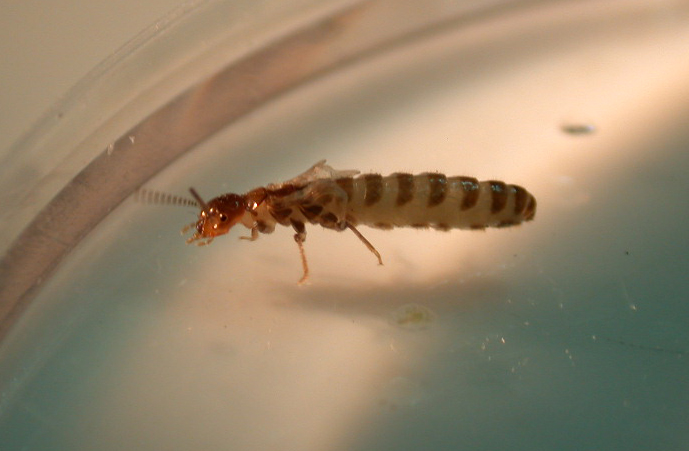Michael Scharf (BS '91, MS '93, PhD '97) Helps to Develop Genetic Pesticide in UF Lab
PCT Online
May 29, 2008
 |
Termite - Photo by Jody Green |
GAINESVILLE, Fla. — Each year in the United States, termites gnaw away more than $1 billion in structural damage despite an ever growing array of insect control techniques. In this battle, the next generation of weapons could target the termite’s very genes.
“The trend in insect control is to find methods that eliminate the problematic insect without affecting anything else in the environment,” said Michael Scharf, an entomologist with the University of Florida’s Institute of Food and Agricultural Sciences. “What could possibly be more specific than genes that are unique to the insect itself?”
In a paper published online this week in the journal Insect Biochemistry and Molecular Biology, Scharf, along with colleagues Xuguo Zhou, Faith Oi and graduate student Marsha Wheeler, describes the effects of a mixture that, when consumed by termites, causes them to be cripplingly deformed after molting.
The active agent in this “genetic pesticide” is RNA—small strips of genetic material that, within a cell, carry the instructions encoded in DNA to other cellular structures that put those instructions to work.
The team analyzed part of the termite genome and picked a gene that would disrupt the insect’s life cycle and is only found in that type of termite. They then crafted an RNA structure that would interfere with the RNA associated with that specific gene—thus silencing its activity.
“For a long time, the pest control industry has been trying to develop neurotoxin-like chemicals to control insects by trying to tailor the toxin to the insect,” said John Reese, a Kansas State University entomology professor working on a genetic pesticide for aphids. “But all nervous systems are going to be at least a little bit alike, and the chances that you could hurt other creatures or cause damaging pollution are still a major concern.
“But if you try to interfere with a gene of an insect, there’s virtually no chance that you’re going to affect a mammal and almost no chance that you’ll even affect an insect that’s a close relative to the target species,” Reese added.
RNA interference techniques are commonly used at genetic research institutions across the nation. They are typically used to discover what a gene does in an organism by “silencing” it and seeing what happens.
The process isn’t straightforward, though. Even using sophisticated laboratory techniques, it is difficult to effectively introduce foreign RNA into a mammal’s body, said David Root, project leader of the RNA Interference Consortium at the Broad Institute of the Massachusetts Institute of Technology and Harvard University.
However, certain lower life forms seem to be able to absorb RNA by simply consuming it.
“We can soak a worm in an RNA mix, and it will have an effect,” Root said. “But even our best lab tricks aren’t completely reliable at getting RNA interference to work in a mouse. And humans are way more complex than mice.”
Despite certain pests’ susceptibility to RNA interference, any marketable genetic pesticide is still many years away from development, Scharf said. When and if they are put into use, however, they may solve another major problem plaguing modern insecticides.
Insects tend to build resistance to toxins that affect their nervous system. This makes treating termites and other household pests tricky, but becomes a much more major issue for treating agricultural pests.
Continuously rotating between crop pesticides is costly. And when pests grow resistant, farmers sometimes compensate by using more of the toxins—which can seep into groundwater or even drift by air into surrounding areas.
The type of changes required to adapt to genetic pesticides would be much more difficult for farm pests to overcome. And even if they did, there are thousands of genes within an insect’s genome that could be similarly targeted.
In the case of the termite, there is much interest by the U.S. Department of Energy to sequence the insect’s entire genome to shed light on biological processes that could help researchers find ways to break down woody cellulosic materials into alternative fuels such as ethanol. So the same work that might someday help power our cars could also keep our homes from being chewed to the ground.
|